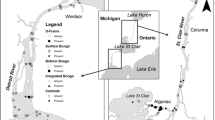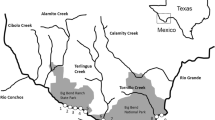Abstract
The duration of the ammocoete life stage in Pacific lamprey (Entosphenus tridentatus) is not well understood, particularly in southern latitudes, hampering the development of conservation strategies. We studied the development of anadromous Pacific lamprey from hatchling to transformation into macrophthalmia near the southern extent of their range. Lampreys were absent from San Luis Obispo drainage in Southern California for over 6 years, but the drainage was naturally recolonized, with ammocoetes first detected again in 2017. This provided an opportunity to examine in-river growth and development using repeated sampling. We estimated ammocoetes transformed into macrophthalmia in as little as 2.6 years, one of the shortest larval durations documented for the species and at least half that assumed in studies of other wild populations. This is the first estimate of time-to-transformation for Pacific lamprey in its southern range and provides insights into adaptive strategies and refinement of recovery approaches for lamprey species worldwide.



Similar content being viewed by others
Data availability
Data published in this manuscript are available upon request.
Code availability
Not applicable.
References
Beamish RJ (1980) Adult biology of the river lamprey (Lampetra ayresii) and the Pacific lamprey (Lampetra tridentata) from the Pacific coast of Canada. Can J Fish Aquat Sci 37:1906–1923
Beamish RJ, Levings CD (1991) Abundance and freshwater migrations of the anadromous parasitic lamprey, Lampetra tridentata, in a tributary of the Fraser River, British Columbia. Can J Fish Aquat Sci 48:1250–1263
Beamish RJ, Northcote TG (1989) Extinction of a population of anadromous parasitic lamprey, Lampetra tridentata, upstream of an impassable dam. Can J Fish Aquat Sci 46:420–425
Bowen S, Yap M (2018) Crowding reduces feeding rate, effectiveness of diet selection, and efficiency of digestion by northern brook lamprey ammocoetes (Ichthyomyzon fossor). Environ Biol Fishes 101:1385–1394. https://doi.org/10.1007/s10641-018-0785-4
Brumo, AF, Grandmontagne L, Namitz SN and Markle DF (2009) Approaches for monitoring Pacific Lamprey spawning populations in a coastal Oregon stream. Pages 203–222 in L. R. Brown, S. D. Chase, M. G. Mesa, R. J. Beamish,and P. B. Moyle, editors. 2009. Biology, management, and conservation of lampreys in North America. American Fisheries Society, Symposium 72, Bethesda, Maryland
California Environmental Flows Working Group (2021) California Natural Flows Database: functional flow metrics v1.2.1 https://river.codefornature.org/. Accessed Nov 2021
Clemens BJ et al (2019) Marine biology of the Pacific lamprey Entosphenus tridentatus. Rev Fish Biol Fisheries 29:767–788
Dawson HA, Quintella BR, Almeida PR, Treble AJ, Jolley JC (2015) The ecology of larval and metamorphosing lampreys. In: Docker MF (ed) Lampreys: biology, conservation and control. Springer, Dordrecht, pp 75–137
Dawson HA, Higgins-Weier CE, Steeves TB, Johnson NS (2021) Estimating age and growth of invasive sea lamprey: a review of approaches and investigation of a new method. J Great Lakes Res 47:S570–S579
Derosier AL, Jones ML, Scribner KT (2007) Dispersal of sea lamprey larvae during early life: relevance for recruitment dynamics. Environ Biol Fishes 78(3):271–284
Goodman DH, Reid SB, Docker MF, Haas GR, Kinziger AP (2008) Mitochondrial DNA evidence for high levels of gene flow among populations of a widely distributed anadromous lamprey Entosphenus tridentatus (Petromyzontidae). J Fish Biol 72:400–417
Goodman DH, Reid SB (2015) Regional implementation plan for measures to conserve Pacific lamprey (Entosphenus tridentatus), California – South Central Coast Regional Management Unit. U.S. Fish and Wildlife Service, Arcata Fish and Wildlife Office, Arcata Fisheries Technical Report Number TR 2015–25, Arcata, California
Goodman DH, Reid SB, Som NA, Poytress WR (2015) The punctuated seaward migration of Pacific lamprey (Entosphenus tridentatus): environmental cues and implications for streamflow management. Can J Fish Aquat Sci 72:1817–1828
Gunckel SL, Jones KK, Jacobs SE (2009) Spawning distribution and habitat use of adult Pacific and western brook lampreys in Smith River, Oregon. In Brown LR et al. (eds) American Fisheries Society Symposium Vol. 72 Maryland, pp 173–189
Hess JE, Paradis RL, Moser ML, Weitkamp LA, Delomas TA, Narum SR (2021) Robust recolonization of Pacific lamprey following dam removals. Trans Am Fish Soc 150:56–74
Jones ML, Bergstedt RA, Twohey MB, Fodale MF, Cuddy DW, Slade JW (2003) Compensatory mechanisms in Great Lakes sea lamprey populations: implications for alternative control strategies. J Great Lakes Res 29(Suppl 1):113–129
Knowles FGW (1941) The duration of larval life in ammocoetes and an attempt to accelerate metamorphosis by injections of an anterior-pituitary extract. Proceedings of the Zoological Society of London 3:101–109
Lampman R, Moser M, Jackson A, Rose R, Gannum A, Barron J (2016) Developing techniques for artificial propagation and early rearing of Pacific lamprey (Entosphenus tridentatus) for species recovery. In: Orlov A, Beamish R (eds) Jawless Fishes of the World, vol 2. Cambridge Scholars Publishing, pp 160–195
Mallatt J (1983) Laboratory growth of larval lampreys (Lampetra (Entosphenus) tridentata Richardson) at different food concentrations and animal densities. J Fish Biol 22(3):293–301
Manion PJ, Smith BR (1978) Biology of larval and metamorphosing sea lampreys, Petromyzon marinus, of the 1960 year class in the Big Garlic River, Michigan, part II, 1966–72 (No. 30, pp. 0–35). Great Lakes Fishery Commission
Manzon RG, Youson JH, Holmes JA (2015) Lamprey metamorphosis. In: Docker MF (ed) Lampreys: biology, conservation and control. Fish and Fisheries monograph series, vol 1. (pp 139–214) Springer, New York
McGree M, Whitesel TA, Stone J (2008) Larval metamorphosis of individual Pacific lampreys reared in captivity. Trans Am Fish Soc 137:1866–1878
Mecklenburg CW, Mecklenburg TA, Thorsteinson LK (2002) Fishes of Alaska. American Fisheries Society, Maryland
Meeuwig MH, Bayer JM (2005) Morphology and aging precision of statoliths from larvae of Columbia River Basin lampreys. N Am J Fish Man 25:38–48
Moser ML, Hume JB, Aronsuu KK, Lampman RT, Jackson AD (2019) Lamprey reproduction and early life history: insights from artificial propagation. In: Docker MF (ed) Lampreys: Biology. Conservation and Control, Springer, Dordrecht, Netherlands, pp 187–245
Morkert SB, Seelye SWD, JG, (1998) Evidence for early metamorphosis of sea lampreys in the Chippewa River, Michigan. N Am J Fish Man 18:966–971
Murdoch SP, Docker MF, Beamish FWH (1992) Effect of density and individual variation on growth of sea lamprey (Petromyzon marinus) larvae in the laboratory. Can J Zool 70:184–188
R Core Team (2017) R: a language and environment for statistical computing. R Foundation for Statistical Computing. Vienna, Austria. https://www.R-project.org/. Accessed Dec 2021
Reid SB, Goodman DH (2015) Detectability of Pacific lamprey occupancy in western drainages: implications for distribution surveys. Trans Am Fish Soc 144:315–322
Reid SB, Goodman DH (2016) Pacific lamprey in coastal drainages of California: occupancy patterns and contraction of the southern range. Trans Am Fish Soc 145:703–711
Reid SB, Goodman DH (2020) Natural recolonization by Pacific lampreys in a southern California coastal drainage: implications for their biology and conservation. N Am J Fish Man 40:335–341
Renaud CB (2011) Lampreys of the world. An annotated and illustrated catalogue of lamprey species known to date. Food and Agriculture Organization of the United Nations
Ruiz-Campos G, Gonzalez-Guzman S (1996) First freshwater record of Pacific lamprey, Lamptera tridentata, from Baja California, Mexico. California Fish and Game 82:144–146
Stone J (2006) Observations on nest characteristics, spawning habitat, and spawning behavior of Pacific and western brook lamprey in a Washington stream. Northwest Nat 87:225–232
Yamazaki Y, Fukutomi N, Oda N, Shibukawa K, Niimura Y, Iwata A (2005) Occurrence of larval Pacific lamprey Entosphenus tridentatus from Japan, detected by random amplified polymorphic DNA (RAPD) analysis. Ichthyol Res 52:297–301
Yamazaki Y, Fukutomi N, Takeda K, Iwata A (2003) Embryonic development of the Pacific lamprey, Entosphenus tridentatus. Zool Sci 20:1095–1098
Youson JH (2003) The biology of metamorphosis in sea lampreys: endocrine, environmental, and physiological cues and events, and their potential application to lamprey control. J Great Lakes Res 29(Suppl. 1):26–49
Acknowledgements
We extend our thanks to F. Otte (City of San Luis Obispo); D. Highland, D. Michniuk, and D. Baldwin (California Department of Fish and Wildlife); P. Kalan (California Polytechnic State University); the San Luis Obispo Land Conservancy—all active members of the Central Coastal California Lamprey Working Group—as well as members of the California Conservation Corps who have assisted in adult and larval surveys. This manuscript benefitted from the thoughtful review of four anonymous reviewers. The findings and conclusions in this manuscript are those of the authors and do not necessarily represent those of the United States Fish and Wildlife Service. Reference to trade names does not imply endorsement by the US Government.
Funding
Funding for this effort and other lamprey conservation efforts in California was provided by the US Fish and Wildlife Service.
Author information
Authors and Affiliations
Corresponding author
Ethics declarations
Ethics approval
Sampling efforts were carried out according to the Guidelines for the Use of Fishes in Research published in 2014 by the joint committee of the American Fisheries Society, the American Institute of Fishery Research Biologists, and the American Society of Ichthyologists and Herpetologists.
Conflict of interest
The authors declare no competing interest.
Additional information
Publisher's note
Springer Nature remains neutral with regard to jurisdictional claims in published maps and institutional affiliations.
Rights and permissions
About this article
Cite this article
Goodman, D.H., Reid, S.B. Rapid development of larval Pacific lamprey Entosphenus tridentatus in southern populations provides adaptive benefits for uncertain flow regimes. Environ Biol Fish 105, 403–411 (2022). https://doi.org/10.1007/s10641-022-01236-6
Received:
Accepted:
Published:
Issue Date:
DOI: https://doi.org/10.1007/s10641-022-01236-6




